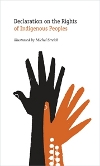Declaration on the rights of indigenous peoples

Illustrated
by Michel Streich. Allen and Unwin, 2009.
(Age 10
+ years) Recommended. Two hands - one orange
and one black - reach upwards on the otherwise plain white
cover. It
is a fitting symbol for a declaration of rights which was written in
hope and has
yet to be fully accepted and enacted around the world.
The
declaration is available on the United Nations website but this edition
puts it
in an Australian context. Noted indigenous spokesperson Patrick Dodson
has
written a brief forward. The text concludes with an explanation of the
challenges facing indigenous people, a history of the declaration's
development
and its relevance to the struggle for indigenous rights and survival in
Australia. The author of this postscript is not identified but it was
clearly
written for an Australian audience, some of whom will be surprised to
learn
that in 2007, when the United Nations adopted the declaration,
Australia was
one of only four countries to vote against it. This year, our federal
government
endorsed the declaration.
Each of the
46 articles is accompanied by a striking, stylised drawing. Michel
Streich's ability
to sum up an issue in a sparse but telling illustration has been honed
through
years of contributing to newspapers and magazines.
Published in
association with Amnesty International, this small, hardcover edition
of the
declaration is timely. It is listed
on
the publisher's website as a 'gift book' and would certainly make a
satisfactory present or award. However,
with its companion volume, The universal declaration of human rights,
it may
also remind readers that reconciliation and human rights concern us all.
Elizabeth
Bor